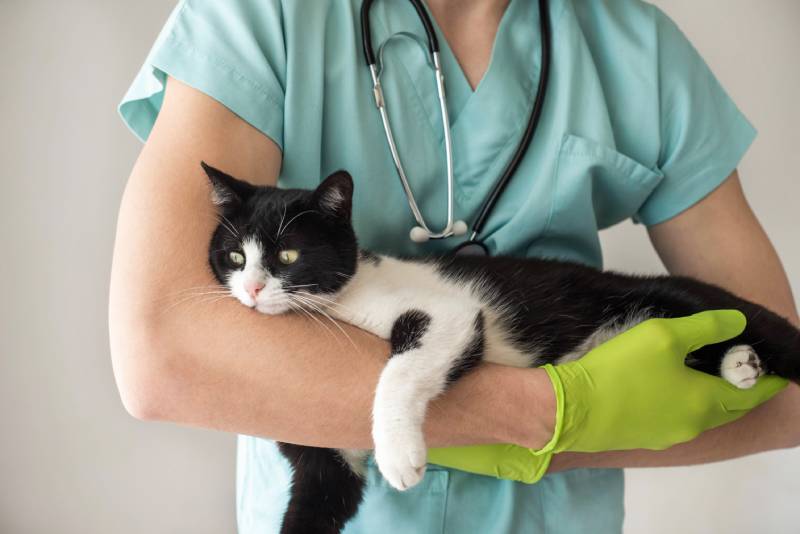
Given water’s vital importance to nearly every bodily function, you’re right to worry if your cat can’t (or won’t) drink enough of it during the day. Cats can only safely go about 24 hours without water before dehydration starts to set in. Without relief, it will only be another few days before they die.
Monitoring and quickly responding to your cat’s drinking habits is crucial in ensuring their daily safety and satisfaction. We’ll discuss how long your cat can go without water, how to identify signs of dehydration, and steps to promote healthy drinking habits.
How Long Can Cats Survive Without Water?

Cats can survive for up to two weeks without food, but without water, they will not survive longer than 3–4 days. Dehydration occurs within 24 hours after their last drink. Environmental factors such as high ambient temperatures can accelerate the onset of signs, as can health conditions like diarrhea or diabetes. Whether or not there is food available, and in what form it is, will also have an impact.
How Much Water Should Cats Drink?
Water intake requirements vary on an individual basis. But generally, cats need around 4 ounces (½ cup) of water for every 5 pounds of body weight daily. Diet, environment, and health can increase or decrease the amount your cat drinks from their bowl. Wet food can have a significant impact, as it contains up to 80% water, so your cat will likely drink much less than they will on a dry food diet, with some rarely visiting the water bowl.
Increases in water loss resulting in a higher need for hydration can occur from exhaustion or various medical conditions, such as:
Your vet is the best resource for understanding your cat’s daily water needs. They can assess your cat’s hydration, diet, medications, and age-related concerns that may cause their thirst to fluctuate.
To make matters easy, cats regulate their water intake, generally drinking as much, or as little, as their body needs. While obesity is always a concern with an overfed kitty, water toxicity from drinking too much is extremely uncommon. Providing a consistent supply of fresh water at all times is the best thing you can do for your cat. If you notice your cat is drinking more than usual, discuss potential medical conditions and other behavioral changes with your vet as soon as possible.
Signs of Dehydration
Water affects tissues and organ function throughout the body, so a lack thereof can cause several physical signs. One of the best tests for hydration is the skin pinch test. By gently pinching and lifting the loose skin at the back of your cat’s neck, you can see how it snaps back after you release it. If the skin is slow to fall into place and remains plucked up, your cat is dehydrated.
Cats may succumb to heat stroke in hot temperatures if they can’t get enough water. Signs of stress can include lethargy, panting, drooling, and a high temperature. The effects can worsen into vomiting, rapid heart rate, and eventual collapse, seizures, or coma.
If your cat is showing signs of dehydration, contact your vet. Vets will examine your cat for disease and other potential causes, administering blood and urine tests to determine the best treatment.

Why Isn’t My Cat Drinking Water?
Cats may reduce their water drinking for several medical or environmental reasons. In many cases, something about the drinking experience may make them reject their water, such as:
Cats may also lack access to water. Even if you ensure no physical barriers, multiple cats in the house may cause pets to not allow others around their territory, blocking them from using water dishes.
Health conditions can play a significant role in a cat’s changing water consumption. Dental problems, gastrointestinal upset, and arthritis may make drinking unpleasant, causing your cat to avoid it as much as possible. Any uncertainty over a sudden shift in drinking habits should result in an immediate conversation with your vet.
How to Get Your Cat to Drink
Cats have unique preferences and numerous reasons for not drinking water, making it challenging to pinpoint the solution immediately. It often takes trial and error with several approaches to fix the issue. Here are a few tips to help you coax your kitty into staying hydrated:
Cat Drinking Fountains
Investing in a water fountain is an inexpensive and effortless way to improve your cat’s drinking experience. It continuously cycles water through filters to ensure it doesn’t get stagnant or dirty. The flow of water avoids stagnation and adds interest. Plus, the falling water positions drinkable water at several heights, allowing pets of different sizes to drink comfortably.
Monitor your cat’s water intake and become familiar with what is normal for them. This will make it easier to notice when anything changes. Ensure they’re eating and drinking enough, and check the litter box for any abnormal waste, like diarrhea or excessive urine, that might indicate added water loss.

Final Thoughts
Hydration is one aspect of your cat’s routine that you must never neglect. It often takes less than a day for dehydration to take effect, putting your cat in increasing peril with every additional hour without water. The rules are simple: always ensure access to a number of water sources, and pay attention to your cat. With quick daily checks, you can respond early to changes in behavior to resolve the issue and avoid a potentially life-threatening situation for your pet.
Featured Image Credit: Punyaphat Larpsomboon, Shutterstock








